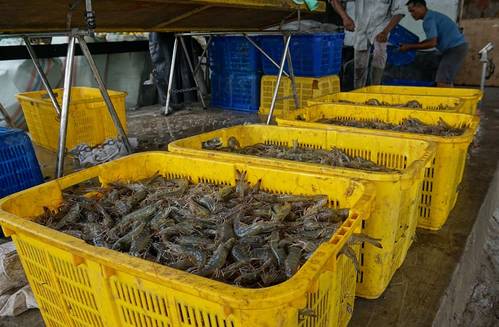Optimizing Aquaculture with Sonar
As Bubba Blue says in the movie Forest Gump there are an endless number of ways to prepare shrimp, which is probably why shrimp are one of the most consumed seafoods in the world.
Traditional methods of wild-capture fishing cannot possibly satisfy the ever-increasing demand. Aquaculture, or the practice of farming marine life, has increased to meet this demand and now accounts for over half of all shrimp production. However, the shrimp aquaculture industry operates with little understanding of how much shrimp is in a pond. Farmers must take a “best guess” approach that ultimately results in incomplete and inaccurate information.
So how does a shrimp farmer measure their stock accurately and determine if their supply is large enough to meet market demands? A combination of JW Fishers technology and the ingenuity of an experienced aquaculture professional resulted in innovative solutions to this problem in Maryland.
JW Fishers SCAN-650 sector scanning sonar is a tool widely used throughout the world. The SCAN-650 produces a detailed image of the underwater environment regardless of the water visibility. It does this by sending out a sound wave that reflects off objects on the bottom or in the water column. The reflected wave returns to the sonar head where it is received and sent to the surface for display.
Minnowtech LLC was founded in 2018 in Baltimore, Md. as a collaborative effort between Dr. Suzan Shahrestani and Early Charm Ventures. Early Charm Ventures is a start-up studio that co-founds early stage intellectual property intensive companies out of universities and federal labs. According to their website, Minnowtech “provides a software imaging platform to enable shrimp farmers to estimate shrimp abundance non-invasively with precision.” Using their data-based imaging tool, “shrimp farmers optimize the health and growth of their hatcheries, enhancing harvest of market-size shrimp while minimizing risks to juvenile shrimp.”
Using a JW Fishers SCAN-650A, Dr. Suzan Shahrestani is investigating ways of quantifying shrimp in these facilities. Using the high-resolution data output from the sector scan, Shahrestani provides shrimp farmers with meaningful information on their biomass and behavior to help maximize efforts and increase production. Shrimp biomass analysis empowers farms to make critical and timely decisions for their business. Currently, farmers have few ways to accurately measure how many shrimp they have. The yield amount is also a guess for them because they are using nets for sampling that are up to 50% inaccurate. Without the in (feed) and out (crop yield), their understanding of how efficiently they are growing shrimp is poor. This makes it very challenging to improve efficiency or FCR (Feed Conversion Ratio) with new feeds, feeding regimes, or treatments that might optimize pond and growth conditions. A farmer that does not know how much biomass they are producing or is even capable of producing with some sense of consistency will have a very difficult time optimizing farm operations.
 (Photo: JW Fishers)
(Photo: JW Fishers)















 December 2025
December 2025



